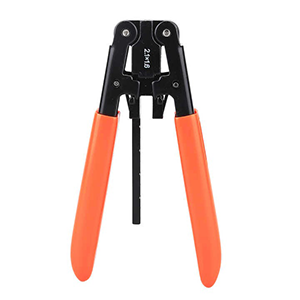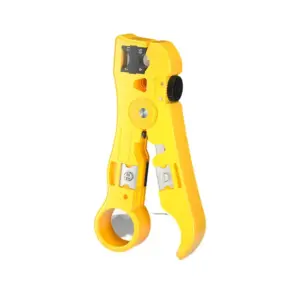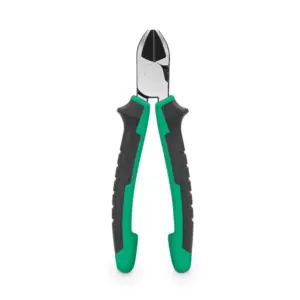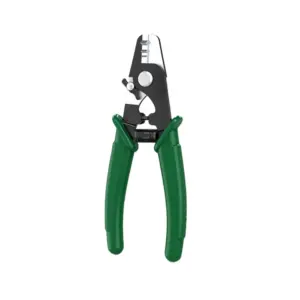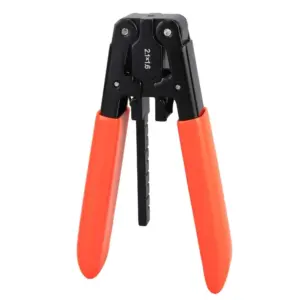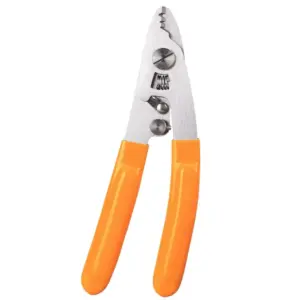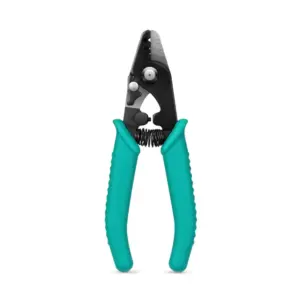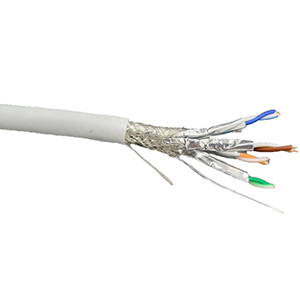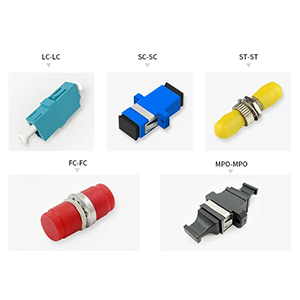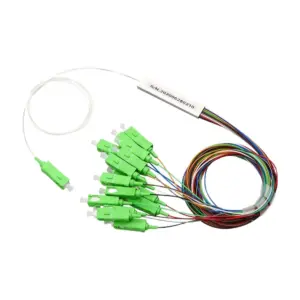Hello everyone! I believe you must be well aware of the important role of optical fiber stripping tools in optical fiber installation and maintenance. As a key fiber connection construction tool, the fiber stripping tool can not only protect the fiber core, but also greatly improve the connection efficiency. Today I am very happy to provide you with an in-depth analysis of the technical characteristics, main types and correct use and maintenance methods of optical fiber stripping tools. By fully understanding the advantages of optical fiber stripping tools, I believe you will be able to choose the best solution for your optical fiber network and further improve the overall connection quality and construction efficiency.
Overview of fiber stripping tools
Let me give you an overview of fiber stripping tools:
What is a fiber stripping tool
- Fiber stripping tools are tools and equipment specially used to prepare fiber end faces.
- It can safely and efficiently strip off the outer sheath and buffer layer on the optical fiber to expose the optical fiber core.
- This process is a key step in fiber end-face preparation, which provides the necessary prerequisites for subsequent fiber splicing or connection.
What is the function of fiber stripping tool:
- Protect the optical fiber core from damage: The precise stripping design can avoid damage to the optical fiber core to the greatest extent.
- Improving the efficiency of optical fiber connection construction: The automated stripping process greatly improves work efficiency.
- Ensure fiber end face quality: Good stripping effect lays the foundation for subsequent fiber processing.
- Convenience for fiber optic network construction and maintenance: Fiber stripping tools are important auxiliary equipment for fiber optic connection work.
The development history of optical fiber stripping tools:
- The earliest fiber stripping tools were manually operated blade tools, which were less efficient.
- Then automated stripping tools appeared, which greatly improved the efficiency of fiber end-face preparation.
- Today, fiber stripping tools with different performance and functions are widely used in fiber optic network construction.
- It has become one of the indispensable and important tools and equipment in optical fiber connection construction.
In general, optical fiber stripping tools play a key role in protecting optical fiber cores and improving construction efficiency. They are indispensable and important auxiliary equipment for optical fiber network construction. With the continuous advancement of technology, fiber stripping tools have been widely used and popularized in the industry.
Technical characteristics of optical fiber stripping tools
Let me introduce you to the technical characteristics of fiber stripping tools in detail:
Main features of optical fiber stripping tools:
- Striping blade: Using a precision-ground blade, it can safely strip the outer layer of the optical fiber.
- Fiber positioning mechanism: It can fix and position the optical fiber to ensure the stability of the stripping process.
- Adjustment mechanism: The stripping depth and length can be adjusted, suitable for optical fibers of different specifications.
- Waste collection chute: collects the peeled outer material to keep the working environment clean and tidy.
- Electric drive: Some high-end peeling tools use electric drive to achieve automated operation.
The differences between different types of peeling tools:
- Manual stripping tool: simple to operate, suitable for small-scale fiber optic connection construction.
- Electric stripping tools: High degree of automation, suitable for large-scale optical fiber network construction.
- Adjustable stripping tool: It can be adjusted according to different fiber diameters and has strong applicability.
- Special stripping tools: designed for special optical fibers, such as micro optical fibers, metal-coated optical fibers, etc.
Key technical indicators of optical fiber stripping tools:
- Striping accuracy: determines the quality of the optical fiber end face after stripping and affects the splicing loss.
- Strip length adjustment range: determines the applicability of the tool and meets the requirements of different connectors.
- Skin blade life: determines the service life and maintenance cost of the tool.
- Operation convenience: directly affects the work efficiency of optical fiber construction personnel.
In general, the precision structural design and excellent performance of fiber stripping tools are the key to ensuring the quality of fiber end-face preparation. Different types of stripping tools specifically meet the needs of various optical fiber network construction and are essential and important tools and equipment.
Main types of fiber stripping tools
Let me introduce you to the main types of fiber stripping tools, as well as their characteristics and applicable scenarios in different aspects:
Common types of fiber stripping tools:
- Manual stripping tool: Use a blade to manually strip off the outer layer of the optical fiber, which is simple and convenient to operate.
- Electric peeling tool: Uses electric drive to realize automated peeling process.
- Adjustable peeling tool: It has the function of adjusting the length and depth of peeling, and has strong applicability.
- Special stripping tools: designed for special optical fibers, such as micro optical fibers, metal-coated optical fibers, etc.
What are the characteristics of various types of peeling tools:
- Hand tools: Simple and convenient to operate, suitable for small-scale fiber optic connection construction. The quality of peeling depends on the proficiency of the operator.
- Power tools: High degree of automation, which improves the stability and efficiency of the peeling process. The peeling accuracy is high and the fiber end face quality can be ensured.
- Adjustable tools: suitable for different specifications of optical fibers, with strong flexibility. High-precision control of the peeling process is usually achieved.
- Special tools: Customized design for the needs of special optical fibers. It can better adapt to the stripping requirements of special optical fibers.
Applicable scenarios for different peeling tools:
- Hand tools: suitable for small-scale, temporary fiber optic connection construction.
- Power tools: suitable for large-scale, standardized optical fiber network construction.
- Adjustable tools: suitable for scenarios that require flexible adaptation to different optical fibers.
- Special tools: suitable for connection construction of special fiber types.
In short, different types of fiber stripping tools have their own characteristics and can meet various fiber connection construction needs from small to large, from standard to special. Choosing the right stripping tool is critical to ensuring fiber end face quality and construction efficiency.
Use and maintenance of optical fiber stripping tools
Let me introduce you to the use and maintenance of fiber stripping tools:
Proper use procedures and precautions for optical fiber stripping tools:
- Read the instructions carefully to understand the various functions and operating steps of the tool.
- Place the optical fiber to be stripped on the positioning mechanism of the tool and fix it firmly.
- Adjust the stripping depth and length settings according to the fiber diameter and stripping length requirements.
- Start the tool and allow the automated peeling process to be completed smoothly, and operate with caution.
- After stripping, check the quality of the fiber end face to ensure that there is no damage or impurity residue.
- Pay attention to keeping the working environment clean and preventing dust from entering the inside of the tool.
Daily maintenance and repair methods of optical fiber stripping tools:
- Regularly clean key components such as blades and slide rails on the surface and inside of the tool.
- Check whether the blade is worn and replace it in time to ensure peeling quality.
- Pay attention to the moving parts of the maintenance tool to ensure smooth operation and no jamming.
- Lubricate regularly according to instructions to maintain good performance and service life of the tool.
- Troubleshoot promptly when a fault is discovered and seek professional maintenance services when necessary.
Common faults of optical fiber stripping tools and their troubleshooting measures:
- Dirty peeling or fiber end face damage: Check whether the blade is worn and need to be replaced with a new blade. Adjust peeling depth and length settings to ensure reasonable parameters
- The tool runs stuck or makes abnormal noise: Check whether the moving parts are flexible and need to be cleaned and lubricated. Check whether there is any foreign matter entering the tool and causing obstruction
- Unable to start normally or circuit failure: Check whether the power connection and switch are normal. If there is a circuit problem, you need to seek professional maintenance services
In short, the correct use and regular maintenance of fiber stripping tools is the key to ensuring fiber end face quality and construction efficiency. Mastering the tool usage procedures and maintenance methods, as well as timely detection and troubleshooting of faults, are important for maximizing the performance of the peeling tool.
Application of optical fiber stripping tools in optical fiber networks
Let me introduce to you the typical applications of optical fiber stripping tools in different optical fiber network application scenarios, and its important role in ensuring the quality of optical fiber connections:
Application of optical fiber stripping tools in data center networks:
- Data centers require large-scale, dense fiber optic connection construction.
- Electric stripping tools improve the efficiency and stability of end face preparation.
- Precise stripping control helps ensure the quality of high-density fiber connections.
Application of optical fiber stripping tools in telecom operator networks:
- Telecom networks have high requirements for the reliability of optical fiber connections.
- Professional-grade stripping tools ensure the quality of every fiber connection point.
- Flexible peeling length adjustment function to adapt to the needs of different network environments.
Application of optical fiber stripping tools in building optical fiber cabling:
- Building networks often require a large number of fiber optic termination connections.
- Manual and adjustable stripping tools are suitable for small-scale construction scenarios.
- The stability of stripping quality helps simplify the subsequent fiber splicing process.
The important role of optical fiber stripping tools in ensuring the quality of optical fiber connections:
- The precise stripping process ensures the cleanliness and integrity of the fiber end face.
- Stable stripping quality lays the foundation for subsequent optical fiber splicing or mechanical connection.
- Good fiber connection quality is the key to ensuring the transmission performance of the entire fiber optic network.
- It is one of the important prerequisites for realizing high-quality optical fiber network construction.
In general, optical fiber stripping tools are widely used in various optical fiber network scenarios such as data centers, telecommunications networks, and building wiring due to their key role in ensuring the quality of optical fiber end faces. It is an indispensable and important auxiliary equipment for optical fiber connection construction and one of the key supports for realizing high-quality optical fiber network construction.
Summary
Fiber stripping tools are undoubtedly a must-have in fiber optic network construction and maintenance. Its excellent performance characteristics, wide range of applicable scenarios, and important impact on the quality of optical fiber connections all highlight the key status of optical fiber stripping tools. Whether in the field of data centers, telecommunications networks or building cabling, fiber stripping tools can inject powerful power into your fiber optic network and ensure high-quality fiber connections.
We provide professional fiber optic accessories products and usage and maintenance services, and are equipped with an experienced technical team to provide you with considerate guidance at any time. If you have any questions about selecting or using fiber stripping tools, please feel free to contact us for communication.
Fiber Stripping Tool FAQ
A fiber optic stripping tool is a specialized tool used to precisely remove the various protective layers (coating, buffer, and jacket) from optical fibers, preparing them for splicing, termination, or other fiber optic installation and maintenance tasks.
Using the proper stripping tool is crucial to ensure the integrity of the optical fiber is maintained and to avoid damaging the delicate fiber during the stripping process.
Typical fiber optic stripping tools include features like interchangeable blades, calibrated depth stops, and stripping holes of various sizes to accommodate different fiber diameters.
Fiber optic stripping tools are designed specifically for the thin, fragile structure of optical fibers, with precise depth control and blade geometry to avoid scratching or breaking the fiber.
There are various types of fiber optic stripping tools, including manual tools, automated tools, and specialty tools for unique fiber optic applications or cable designs.
Proper technique involves aligning the fiber in the tool, adjusting the depth stop, and carefully pulling the tool to remove the desired layer without damaging the fiber.
Fiber optic stripping tools typically support a range of fiber diameters, such as 250 μm, 900 μm, and 3 mm, to cater to different fiber optic cable designs and applications.
Proper maintenance includes cleaning the tool, replacing worn blades, and ensuring the depth stops and other components are functioning correctly for accurate and consistent stripping.
Safety precautions include wearing eye protection, handling the sharp blades with care, and following the manufacturer’s instructions to avoid potential fiber breakage or injury.
In addition to stripping, some fiber optic stripping tools may also have features for scoring, cleaving, or other fiber preparation tasks, depending on the tool’s design and intended use.

